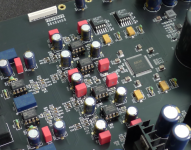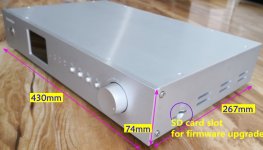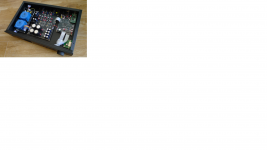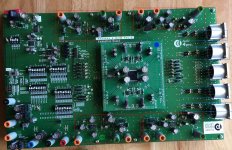And the HXMelody AK4499 2019. This looks very nice with a separate digital board and swappable opamps.
It costs about 1000 USD, so a direct competitor to the Gustard.
Some nice pictures of the interior are here: Доступ с вашего IP-адреса временно ограничен — Авито
Maybe some of the more experienced DAC designers here can add some insight to the technical design of these new Chinese dacs (as far as pictures tell anything)?
This HXMelody turns out to have AD727 opamps in the output, which IMHO is a heartening choice. They also include a SD card slot on the site for firmware updates...
Has anyone experience with this brand?
Attachments
Do I see well? BB OPA2604 for the I/V converters..?
Yes, OPA2604 indeed.
I just discovered that Terry already commented on that in post 28 of this thread. What's your view?
Top one (Wilmer workshop) is using BB OPA2604 opamps for I-V.
IME, (this is my direct experience not something I've read on the internet) is
that the 2604 is a fairly colored opamp and definitely clouds some nformation
in the process of sounding 'sort of nice'. Biasing into class A definitely helps
a lot but ultimately there are better suited opamps for I-V, especially the
AK4499 which has serious OP current swing. It's not the best measuring
opamp either.
If they chose the 2604 based on listening tests then IME something else
must be slightly amiss.
T
The 4499 datasheet suggests 360ohm in the I/V conversion position. Output current at 0dB is +_36mA..
That is a bit higher than the OPA2604 max current. (35mA; OPA1656: 100mA)
Opa2604 is declared to work for 600ohm loads, but here we have 360ohm load..
And though they declare 600 ohm functionality, the distortion is tested at 1kohm load. And it is quite high, with respect to modern references.
Apart from this, the speed, slew rate of the chip are ~ok.
Having a jfet input, it is more EMI tolerant, than the usual bjt opamps (lme49720, opa1612..?)
All in all I think Terry is right, the chip was chosen for it's 'sound', rather than a perfect technical fit.
I had chosen the opa1656 because of it's cmos input (high tolerance, like the 2604, just even better (at a node which sees high frequency noise from the dac))
High current output capability, with extreme low distortion (it had been tested at 600ohm)
Much lover distortion, in fact one of the lowest today;
Finally twice as much speed, 1/3d of noise, and similar slew rate that the 2604.
That is a bit higher than the OPA2604 max current. (35mA; OPA1656: 100mA)
Opa2604 is declared to work for 600ohm loads, but here we have 360ohm load..
And though they declare 600 ohm functionality, the distortion is tested at 1kohm load. And it is quite high, with respect to modern references.
Apart from this, the speed, slew rate of the chip are ~ok.
Having a jfet input, it is more EMI tolerant, than the usual bjt opamps (lme49720, opa1612..?)
All in all I think Terry is right, the chip was chosen for it's 'sound', rather than a perfect technical fit.
I had chosen the opa1656 because of it's cmos input (high tolerance, like the 2604, just even better (at a node which sees high frequency noise from the dac))
High current output capability, with extreme low distortion (it had been tested at 600ohm)
Much lover distortion, in fact one of the lowest today;
Finally twice as much speed, 1/3d of noise, and similar slew rate that the 2604.
Last edited:
I have tried in the past, the 2604 in dac I/V position.
It gave a strong 'wov' effect with a warm, fuzzy sound (i think it was in a tda1540 dac (marantz))
But on the long run it became a bit of too much..
And if we consider that also the 4499 chip is 'getting it' s fame' as a big bold sound with strong bass - the couple would give a real "warm sounding" effect..
It gave a strong 'wov' effect with a warm, fuzzy sound (i think it was in a tda1540 dac (marantz))
But on the long run it became a bit of too much..
And if we consider that also the 4499 chip is 'getting it' s fame' as a big bold sound with strong bass - the couple would give a real "warm sounding" effect..
I have tried in the past, the 2604 in dac I/V position.
It gave a strong 'wov' effect with a warm, fuzzy sound (i think it was in a tda1540 dac (marantz))
But on the long run it became a bit of too much..
And if we consider that also the 4499 chip is 'getting it' s fame' as a big bold sound with strong bass - the couple would give a real "warm sounding" effect..
Yes, warm and fuzzy is a good description. But if you look at real load driving
capacity on Samuel Groners opamp distortion paper, it's a long way off doing the job for AK4499.
TCD
CM distortion.. In fact, I am a bit perplexed also at the choice of the AD797 as the difference amp at output.
In that place usually higher (couple of kohm) sum resistances are applied. So as to not load further the otherwise already heavily loaded I/V converter (360ohm feedback) ; and the summing circuit itself.
Not a configuration where the low noise of the 797 could shine through. A fet/cmos amp could be better. Specially if it is optimized properly for this task - like low CM distortion, with elevated input impedances.
Me do not know either, what is the performance of the 797 in this respect.
I have chosen an OPA828 for that job.
(I know.. 827 could be even better..)
Instead, in the I/V converter, being an inverting configuration - the CM parameters are of less importance.
Ciao, George
In that place usually higher (couple of kohm) sum resistances are applied. So as to not load further the otherwise already heavily loaded I/V converter (360ohm feedback) ; and the summing circuit itself.
Not a configuration where the low noise of the 797 could shine through. A fet/cmos amp could be better. Specially if it is optimized properly for this task - like low CM distortion, with elevated input impedances.
Me do not know either, what is the performance of the 797 in this respect.
I have chosen an OPA828 for that job.
(I know.. 827 could be even better..)
Instead, in the I/V converter, being an inverting configuration - the CM parameters are of less importance.
Ciao, George
Ok.. And hmm.. I have to correct myself.. Groner had measured the 'input impedance linearity' for both the 827 & 797..
That is the CM distortion, with high (100k) input impedances.
And it comes out better for the 797. Very interesting..
Also the CM distortion, although good for the 827, it's even better for the 797.
There is always something to learn..
And yes, the 2604 collapses even/already with 600 ohm load..
That is the CM distortion, with high (100k) input impedances.
And it comes out better for the 797. Very interesting..
Also the CM distortion, although good for the 827, it's even better for the 797.
There is always something to learn..
And yes, the 2604 collapses even/already with 600 ohm load..
Ok.. So it is an old discussion, now I remember.
Here are the measurements of John on the 827, to be confronted by the results in the Groner list. John says it's corrected in a process change.
So the 827 is very good, in fact.
https://www.diyaudio.com/forums/ana...pedance-jfet-input-op-amps-4.html#post4129482
Here are the measurements of John on the 827, to be confronted by the results in the Groner list. John says it's corrected in a process change.
So the 827 is very good, in fact.
https://www.diyaudio.com/forums/ana...pedance-jfet-input-op-amps-4.html#post4129482
For the couple of guys reading this thread who might care, a pic of the AK4499 eval board is attached below. Outlined in red are areas of the PCB dedicated to voltage regulator circuitry for each channel of the dac chip's four analog output sections (hence, four red outlines).
What strikes me about it is that AKM chose to use non-LDO regulators and not even SOA discrete regulators. In addition, they made it easy with jumpers and banana jacks to try other types of regulators. Personally, I think they were trying to say, "Hint, hint!"
What strikes me about it is that AKM chose to use non-LDO regulators and not even SOA discrete regulators. In addition, they made it easy with jumpers and banana jacks to try other types of regulators. Personally, I think they were trying to say, "Hint, hint!"
Attachments
Also.. In the evaluation board, after the reference regulators, there is that series 10ohm inserted, before arriving to the chip. Then the task of providing low frequency low impedance is transmitted to the big local bypass electrolytic caps. In this scheme many properties of an original regulator are attenuated.
Only aspect that remains is how it reacts to an elevated load capacitance..
LDO- s are not all reacting well. In this sense the series resistor helps in decoupling that effect.
Ciao, George
Only aspect that remains is how it reacts to an elevated load capacitance..
LDO- s are not all reacting well. In this sense the series resistor helps in decoupling that effect.
Ciao, George
Last edited:
...Only aspect that remains is...
If one more aspect may be suggested: How does it sound?
Of course, some will object to such a question. I think for sound reproduction purposes, it would not be unreasonable to perform listening comparisons using skilled listeners. Of course, some will object to such a suggestion if measurements look good enough.
Aside from the usual objections to such things, has anyone other than me actually tried it?
Just wondering...
Last edited:
Ok.. And hmm.. I have to correct myself.. Groner had measured the 'input impedance linearity' for both the 827 & 797..
That is the CM distortion, with high (100k) input impedances.
And it comes out better for the 797. Very interesting..
Also the CM distortion, although good for the 827, it's even better for the 797.
There is always something to learn..
And yes, the 2604 collapses even/already with 600 ohm load..
When used well, I still find the AD727 one of the most musical (*) sounding opamps, and not as clinical as the wonderfully fast and clean sounding modern opamps...
It seems that this HXMelody is really tuned by ear. Whether it will be to warm sounding or not remains to be seen (heard)...
(* = highly subjective remark that risks persecution by the science police)
Such audible difference would show up in measurements.And if we consider that also the 4499 chip is 'getting it' s fame' as a big bold sound with strong bass - the couple would give a real "warm sounding" effect..
Yes, it seems a neat little device, but I fear much of it inner parts will inhibit the 4499 performance…
Yes, very much so. But for a very compact device made for phones it could be one of the better solutions available.
- Home
- Source & Line
- Digital Line Level
- AK4499EQ - Best DAC ever



